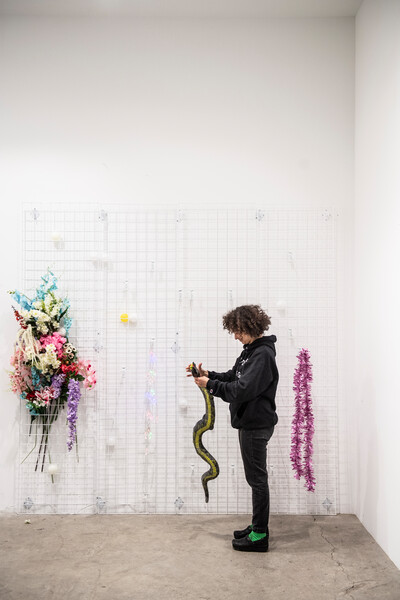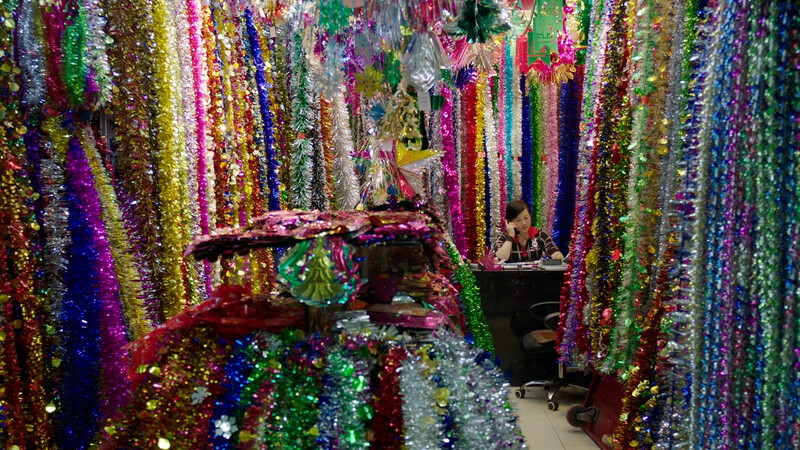Conversations
A conversation between Mika Rottenberg and Madeline Warren

Madeline Warren and Mika Rottenberg. Photo: Sim Canetty-Clarke
Madeline Warren, Director, is a longstanding member of Hauser & Wirth’s New York team. She works with a number of artists, including Mika Rottenberg. Mika joined the gallery in 2018, and Madeline was an emphatic cheerleader heralding her arrival.
This year’s Unlimited will feature Rottenberg’s ‘Cosmic Generator’, a video and installation work depicting a tunnel system populated by an imaginary network of strange characters.
Madeline Warren: When we first met, I asked you how you built the sets in your videos. And I was mortified when you said they were locations! So I’m curious about how you have found these incredible places.
Mika Rottenberg: I’m always surprised when I find locations in the world that look like a set I might construct. In general, in the work, I try to blend fact and fiction, or constructed reality and a different kind of constructed reality. The market in ‘Cosmic Generator’ is also kind of a set, so I’m drawn to locations that already have something kind of fantastic about them.
MW: It’s a set for selling?
MR: Yes, the market is a stage set in a way, because there’s nothing really real—it’s all a display, so in a way, it’s similar to a movie set. Also in the way it triggers your eye and seduces you and draws you in, I found that cinematic.
MW: They look like visual fantasies, which I guess is why I thought you had made them. They look like you made them!
MR: I’d much rather work in locations that already exist and then build maybe a much smaller part. But in a way, it’s appropriation.
MW: The fact that they already exist is amazing, but it’s also scary, I find, that these places are out there.
MR: Well, someone made them! I always say, when people ask me if my work is absurd, I think reality is a lot more absurd than any kind of fiction. But you know, I also found that market really beautiful. The endless patterns, and the endless difference, because these little stores are wholesale, so they present one of each. Say it’s soccer balls; there could be a hundred variations on a similar pattern, which I found amazing. That times a million! So that pattern, but endless, like a fractal.
MW: I’d like to ask about the politics of the work, specifically about ‘Cosmic Generator’, while you may not be giving the answer, do you mean for the work to be political or subversive?
MR: No, I think the subject matter is political, or politically loaded.
MW: But are you choosing it for that reason?
MR: Maybe in choosing places where there is friction, or unsettlement, or a conflict. A conflict can be from something beautiful and seductive but it’s also a bit fucked up. I’m interested in places like that, and that is political. And maybe that is a reaction to the world or to objects and products.
MW: Is that how you decided on Calexico and Mexicali?

Mika Rottenberg. Photo: Sim Canetty-Clarke

Detail of work in progress. Photo: Sim Canetty-Clarke
MR: I was in that area almost 10 years ago and I found out about all these Chinese restaurants in Mexicali. I love Chinese restaurants and I am always interested in that décor, I don’t know why—maybe because it’s about cultural migration and East to West and cultural dispersion. So I was interested in that area.
MW: So when you discovered the market in Yiwu, was it an obvious pairing?
MR: It made a lot of sense. Then I found out about the market from a friend while visiting China. My friend said, ‘That’s where you make Christmas.’ The connection between those two locations—I thought, oh, there is a connection. But what is it, conceptually? This was in 2016 when there was a lot of talk about China and global trade and the border wall. So I thought—there’s the connection. But I started putting these two places together before that connection was so obvious.
MW: And there’s the connection of the 99 cent store.
MR: It is the products that go [from China], and I was thinking about distance and about how that very short distance could feel very long, actually crossing the border, especially now. How the objects from China sometimes arrive quicker to the 99 cent store than the person trying to cross the border, and then how some objects are smuggled, and some are above ground.
MW: What was the process of creating the installation in Münster? And subsequently, the process of making these wall grids.
MR: The store in Münster was just so perfect, I wouldn’t have invented it. It worked because it was really there—an Asian bazaar that went out of business, and that seemed perfect. And then the idea of replicating it in a museum did not seem like a good idea, so I kept thinking about it: what would take the essence of that installation and fit in a museum? At first, I played a lot with these products and then I realized that the grids themselves with the pegs were much more interesting. And of course, you cannot help but think about Duchamp’s ‘Bottle Rack’, and this empty display. Sculpturally, the grid was so much more interesting than the objects. So in the end, there are far fewer objects and it’s more about the grid and an empty display.
‘I always say, when people ask me if my work is absurd, I think reality is a lot more absurd than any kind of fiction.’
MW: In terms of the objects, did you select them from the market?
MR: From the million objects that I’d seen in the market, in the end, just a few really made sense—like the palm tree and the pineapple.
MW: Those seems so specific, they’re tropical...
MR: When I was designing it, there were all these horrible storms, and I kept seeing palm trees upside down and on their sides and deflated, and that kind of resonated in the work. But there’s something also very cheerful and beautiful about a pineapple or a palm tree—there’s always this promise of a tropical vacation, gone bad or something.
MW: It’s another moment of contradiction in your work, given that you are so environmentally conscious, and then you’re using all of these really beautiful plastic things.
MR: I know, because I am obsessed with plastic! But I’m not the only one who’s obsessed with it.
MW: I think you think about it more than people usually do. You don’t use it in your everyday life, but you use it in your artwork.
MR: That’s also why I was using less and less of it. It’s so vibrant and colorful; you only need one little one...

Mika Rottenberg, Cosmic Generator (Loaded #3), 2017 / 2018 © Mika Rottenberg

Mika Rottenberg, Cosmic Generator (Loaded #3), 2017 / 2018 © Mika Rottenberg
‘I’m always surprised when I find locations in the world that look like a set I might construct. In general, in the work, I try to blend fact and fiction, or constructed reality and a different kind of constructed reality.’
MW: And you can fill it with air! In a way, you are putting it up on a pedestal, instead of the yogurt cup that you use for three minutes and throw away—low to high.
MR: I always feel that plastic is like a hijacked material. It’s straining or something because it can’t go back and decompose itself. It’s oil-based, and it’s basically dead plants that are not allowed to go back to the earth, and are put into this shape where they’re trapped.
MW: Poor plastic!
MR: Poor dead plants! Or poor dead animal from like a million years ago… poor dinosaur!
MW: Thinking about ecology and energy, I wanted to ask about the two types of lightbulbs in the work. In the sculptures, there are the LEDs, the string lights that hang off of the grids, and then there’s this incredible scene that repeats itself of the woman smashing the lightbulbs.
MR: That is really about the end of an era and the beginning of another. For me the lightbulb is so about an American industrial revolution and the golden era of manufacturing here. And LED is golden era of manufacturing in China. So it’s the old-fashioned and the new.
MW: It’s also just such a great metaphor for energy—light as energy—and then of course, the energy of her smashing up the bulbs.
MR: Using it for the wrong reasons. Me, and many other artists are obsessed with lightbulbs—the idea of fabricating light and energy and owning it. Lightbulbs are just beautiful. Madeline: Even all smashed up? Mika: Even more beautiful all smashed up!
‘Cosmic Generator (Loaded #3)’ will be on view as part of Hauser & Wirth’s presentation at Art Basel Unlimited, from 13 – 16 June 2019.
